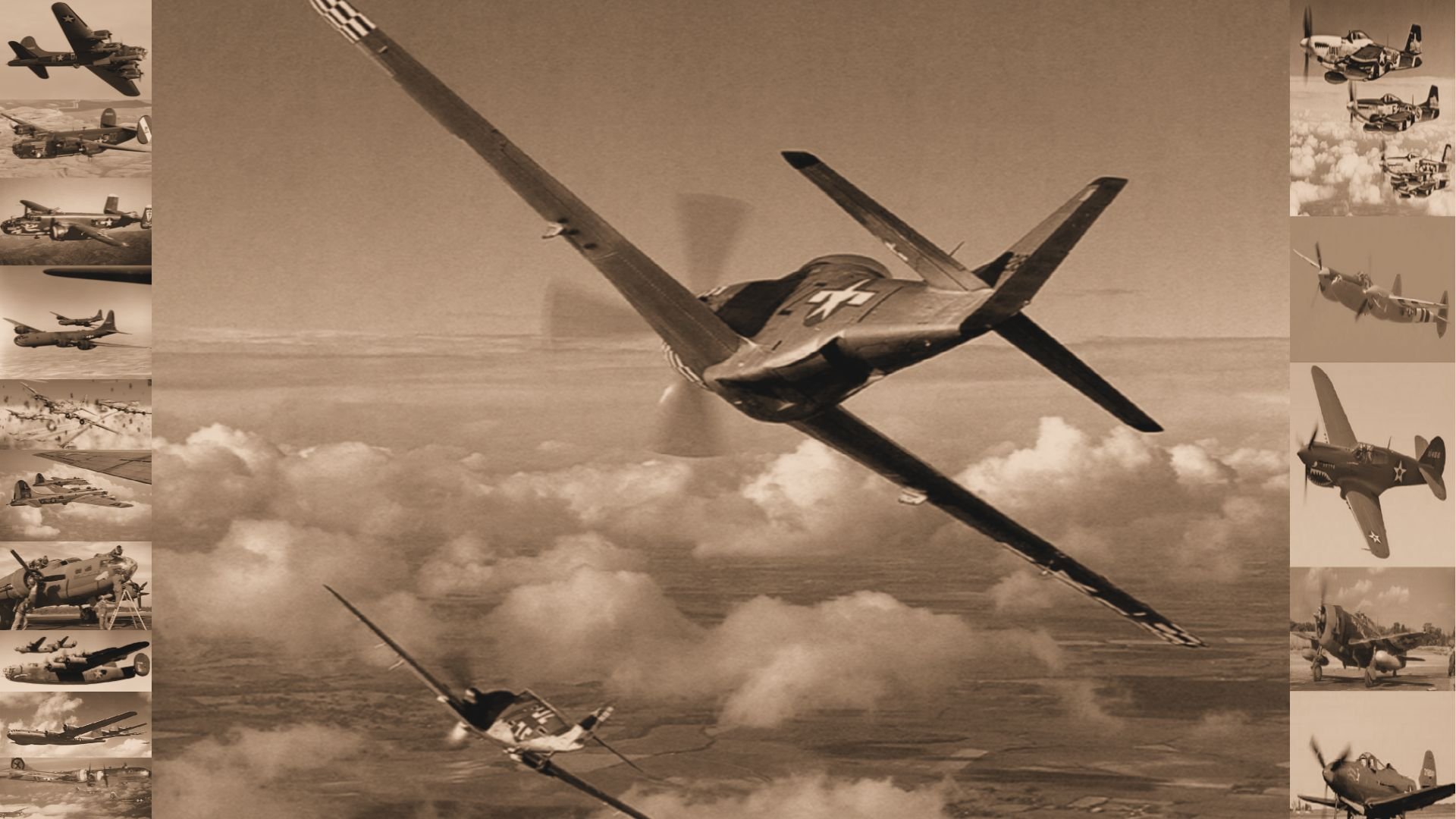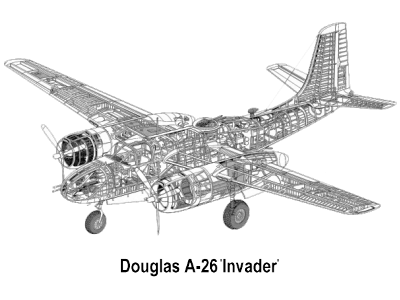


 Douglas A-26 'Invader'
Douglas A-26 'Invader' The Douglas A-26/B-26(redesgnated B-26 in 1948) bomber was the only American bomber to fly missions in three wars. After World War II, it served as a front-line bomber during the Korean War and in the beginning of the the Vietnam War. The A-26, the last aircraft designated as an 'attack bomber', was designed to replace the Douglas A-20 'Havoc/Boston'. It incorporated many improvements over the earlier Douglas designs. The final variant, eventually called the A-26B, was chosen for production.
The Douglas XA-26 prototype first flew on 10 July 1942 at Mines Field, El Segundo. Flight tests revealed excellent performance and handling, but there were problems with engine cooling which led to cowling changes and omission of the propeller spinners on production aircraft, plus modification of the nose landing gear after repeated collapses during testing. The A-26 was originally built in two different configurations. The A-26B had a 'solid' nose, which originally could be equipped with a combination of anything from .50 caliber machine guns, 37mm auto cannon, 20mm or even a 75mm pack howitzer, but normally the solid nose version housed six (or later eight) .50 caliber machine guns, officially termed the 'all-purpose nose', later commonly known as the 'six-gun nose' or 'eight-gun nose'. The A-26C's 'glass' nose was officially termed the 'Bombardier nose'. An A-26C nose section could be exchanged for an A-26B nose section, or vice versa, in a few man-hours, thus physically (and officially) changing the designation and operational role. The 'flat-topped' canopy was changed in late 1944 after about 820 production aircraft, to a clamshell style with greatly improved visibility. In the A-26B (with a solid nose), a crew member seated next to the pilot served as navigator and gun loader for the pilot-operated nose guns. In an A-26C (the glass nose variant), that crew member served as navigator and bombardier, and moved into to the nose section for bombing.
Back to TopA-26s began arriving in Europe in late September 1944 for assignment to the Ninth Air Force and upon its delivery to the 9th Air Force in Europe in November 1944, the A-26 became the fastest US bomber of WWII. The A-26C, with slightly-modified armament, was introduced in 1945. The initial deployment involved 18 aircraft and crews assigned to the 553d Squadron of the 386th Bomb Group. This unit flew its first mission on 6 September 1944. No aircraft were lost on the eight test missions, and the Ninth Air Force announced that it was happy to replace all of its A-20s Havocs and Martin B-26s with the A-26 Invader. By 1945, the 9th AF had flown 11,567 missions, dropping 18,054 tons of bombs, recording seven confirmed kills while losing 67 aircraft. In Italy the Twelfth Air Force's 47th Bomb Group also received the A-26, starting in January 1945. They were used against German transport links, but also for direct support and interdiction against tanks and troop concentrations in the Po valley in the final campaigns in Italy.
In August 1943 the A-26 first saw action with the Fifth Air Force in the Southwest Pacific theater on 23 June 1944, when Japanese-held islands near Manokwari were attacked. The pilots in the 3rd Bomb Group's 13th Squadron, 'The Grim Reapers', who received the first four A-26s for evaluation, found the view from the cockpit to be poor for low-level attack. The 319th Bomb Group worked up on the A-26 in March 1945, joining the initial 3rd BG, with the 319th flying until 12 August 1945. The A-26 operations wound down in mid-August 1945 with only a few dozen missions flown.
Back to TopB-26 Invaders of the 3d Bombardment Group, operating from bases in Southern Japan, were some of the first USAF aircraft engaged in the Korean War, carrying out missions over South Korea on 27 and 28 June, before carrying out the first USAF bombing mission on North Korea on 29 June 1950 when they bombed an airfield outside of Pyongyang. On 10 August 1950, the Air Force Reserve's 452d Bombardment Wing was activated for Korean Service. It flew its first missions in November 1950 from Itazuke Japan doing daylight support with the 3rd Bomb Wing flying night missions. In early 1951 it moved to Pusan East (K-9) Air Base and continued its daylight as well as night intruder missions. In June 1951, it joined the 3rd Bomb Wing in night activity only, dividing the target areas with the 452nd taking the eastern half and the 3rd the western. In May 1952 it was inactivated and all of its aircraft and equipment along with its regular air force personnel were absorbed by the 17th Bomb Wing. During its time as an active unit, the 452nd flew 15,000 sorties (7000 at night) with a loss of 85 crewmen.
In Vietnam, they were commonly used in the Counter-Insurgency (COIN) role, with very heavy armament and extra power. This version, the B-26K, was based in Thailand and was, to confuse things further, called the A-26 for political reasons. B-26s were also used for training, VIP transport, cargo, night reconnaissance, missile guidance and tracking, and as drone-control platforms.
Back to TopThe B-26 flew for the the French Air Force's (Armée de l'air) Bombing Groups (Groupe de bombardement) during the 1950's and also operated in Vietnam over Dien Bien Phu in March and April 1954 during its siege. In early 1961, about 20 B-26Bs, most converted from B-26C configuration, had defensive armament removed, and were fitted with the eight-gun nose, underwing drop tanks, and rocket racks. On 15 April 1961, crewed by Cuban exiles, eight B-26s of the FAL (Fuerza Aérea de Liberación) attacked three Cuban airfields, in an attempt to destroy FAR combat aircraft on the ground. On 17 April 1961, FAL B-26s supported the seaborne Bay of Pigs Invasion of Cuba. The conflict ended on 19 April, after the loss of nine FAL B-26s. The Portuguese Air Force purchased B-26 Invaders covertly for use in Portuguese Angola in 1965, during the Portuguese Colonial War.
The USAF Strategic Air Command operated the redesignated B-26 (RB-26) in service from 1949 through 1950; USAF Europe until 1957; the Tactical Air Command through the late 1960s, and the last examples in service with the Air National Guard through 1972. This has led to some confusion with the Martin B-26 Maurader which was phased out at the end of World War 2.
A-26 Invader versions included the A-26D and A-26E light bombers, GA-26C ground training aircraft, and the KA-26A tanker. Some A/B-26s were equipped for photo reconnaissance, and during the 1960s, some surplus B-26s were used in the target-towing role. Since 1945, over 300 A-26s have been entered on to the FAA U.S. Civil Aircraft Register. During the mid-1950s, A-26s were tested and used as air tankers for suppression of forest and wildland fires. Some 2,503 A-26/B-26 Invaders were built and operating from 1944 through to 1972 in a variety of Air Forces and civilian uses around the world.
Back to Top

|
Specifications(A-26B-15-DL Invader):
Country of Origin: USA Crew: 3 Length: 50 ft 0 in (15.24 m) Wingspan: 70 ft 0 in (21.34 m) Height: 18 ft 3 in (5.64 m) Weight: Empty: 22,850 lb (10,365 kg) Loaded: 27,600 lb (12,519 kg) Powerplant: 2 × Pratt & Whitney R-2800-27 "Double Wasp" radials, 2,000 hp (1,500 kW) each Performance Maximum speed: 355 mph (308 kn, 570 km/h) Range: 1,400 mi (1,200 nmi, 2,300 km) Service ceiling: 22,000 ft (6,700 m) Armament Guns: Up to 8 0.50 in (12.7 mm) M2 Browning machine guns in the nose (1,600 rpg) 8 0.50 in (12.7 mm) M2 machine guns paired in four optional underwing pods 2 0.50 in (12.7 mm) M2 machine guns in remote-controlled dorsal turret 2 0.50 in (12.7 mm) M2 machine guns in remote-controlled ventral turret Bombs: 6,000 lb (2,700 kg) capacity - 4,000 lb (1,800 kg) in the bomb bay plus 2,000 lb (910 kg) carried externally on underwing hardpoints |